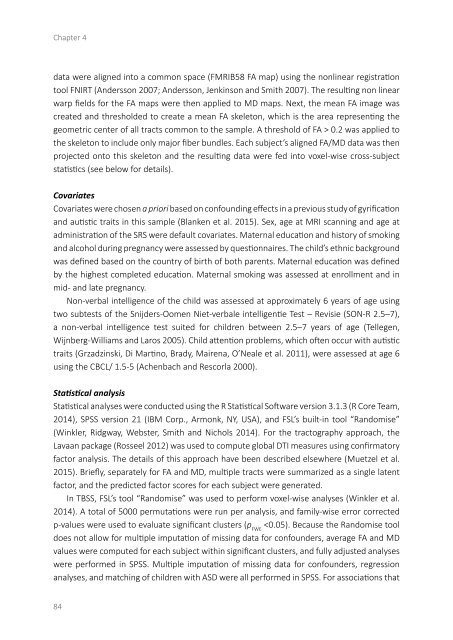On the Spectrum
2lm5UyR
2lm5UyR
You also want an ePaper? Increase the reach of your titles
YUMPU automatically turns print PDFs into web optimized ePapers that Google loves.
Chapter 4<br />
data were aligned into a common space (FMRIB58 FA map) using <strong>the</strong> nonlinear registration<br />
tool FNIRT (Andersson 2007; Andersson, Jenkinson and Smith 2007). The resulting non linear<br />
warp fields for <strong>the</strong> FA maps were <strong>the</strong>n applied to MD maps. Next, <strong>the</strong> mean FA image was<br />
created and thresholded to create a mean FA skeleton, which is <strong>the</strong> area representing <strong>the</strong><br />
geometric center of all tracts common to <strong>the</strong> sample. A threshold of FA > 0.2 was applied to<br />
<strong>the</strong> skeleton to include only major fiber bundles. Each subject’s aligned FA/MD data was <strong>the</strong>n<br />
projected onto this skeleton and <strong>the</strong> resulting data were fed into voxel-wise cross-subject<br />
statistics (see below for details).<br />
Covariates<br />
Covariates were chosen a priori based on confounding effects in a previous study of gyrification<br />
and autistic traits in this sample (Blanken et al. 2015). Sex, age at MRI scanning and age at<br />
administration of <strong>the</strong> SRS were default covariates. Maternal education and history of smoking<br />
and alcohol during pregnancy were assessed by questionnaires. The child’s ethnic background<br />
was defined based on <strong>the</strong> country of birth of both parents. Maternal education was defined<br />
by <strong>the</strong> highest completed education. Maternal smoking was assessed at enrollment and in<br />
mid- and late pregnancy.<br />
Non-verbal intelligence of <strong>the</strong> child was assessed at approximately 6 years of age using<br />
two subtests of <strong>the</strong> Snijders-Oomen Niet-verbale intelligentie Test – Revisie (SON-R 2.5–7),<br />
a non-verbal intelligence test suited for children between 2.5–7 years of age (Tellegen,<br />
Wijnberg-Williams and Laros 2005). Child attention problems, which often occur with autistic<br />
traits (Grzadzinski, Di Martino, Brady, Mairena, O’Neale et al. 2011), were assessed at age 6<br />
using <strong>the</strong> CBCL/ 1.5-5 (Achenbach and Rescorla 2000).<br />
Statistical analysis<br />
Statistical analyses were conducted using <strong>the</strong> R Statistical Software version 3.1.3 (R Core Team,<br />
2014), SPSS version 21 (IBM Corp., Armonk, NY, USA), and FSL’s built-in tool “Randomise”<br />
(Winkler, Ridgway, Webster, Smith and Nichols 2014). For <strong>the</strong> tractography approach, <strong>the</strong><br />
Lavaan package (Rosseel 2012) was used to compute global DTI measures using confirmatory<br />
factor analysis. The details of this approach have been described elsewhere (Muetzel et al.<br />
2015). Briefly, separately for FA and MD, multiple tracts were summarized as a single latent<br />
factor, and <strong>the</strong> predicted factor scores for each subject were generated.<br />
In TBSS, FSL’s tool “Randomise” was used to perform voxel-wise analyses (Winkler et al.<br />
2014). A total of 5000 permutations were run per analysis, and family-wise error corrected<br />
p-values were used to evaluate significant clusters (p FWE<br />


